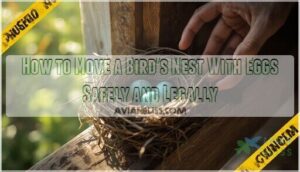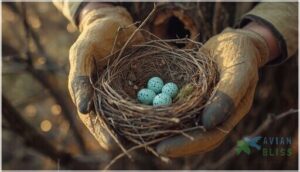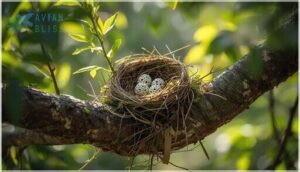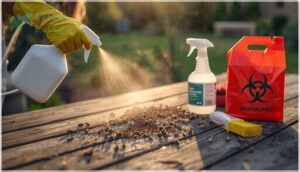This site is supported by our readers. We may earn a commission, at no cost to you, if you purchase through links.

You spot a nest tucked into the eaves of your porch, and inside are three delicate blue eggs. It’s charming until you realize the location puts the birds at risk, or worse, interferes with urgent home repairs. Your instinct might be to carefully move it to a safer spot, but here’s what most people don’t know: relocating a bird’s nest with eggs isn’t just tricky, it’s often illegal.
The Migratory Bird Treaty Act protects over 1,000 species, meaning you could face serious penalties for disturbing a nest without proper authorization. Even with good intentions, the wrong move can lead to abandonment, injury, or legal trouble.
Understanding the rules, recognizing when intervention is truly necessary, and knowing how to proceed safely can make all the difference for both you and the birds.
Table Of Contents
- Key Takeaways
- Is It Legal to Move a Bird’s Nest With Eggs?
- When is Moving a Nest Necessary?
- How to Assess if You Can Move The Nest
- Safety Precautions Before Handling a Nest
- Step-by-Step Guide to Moving a Nest With Eggs
- What to Do After Relocating The Nest
- Frequently Asked Questions (FAQs)
- Can I relocate a bird’s nest with eggs?
- What happens if you disturb a birds nest with eggs?
- How to safely remove a bird nest with eggs?
- Will a mother bird come back if you touch her nest?
- How long does it take for eggs to hatch?
- Can I incubate the eggs myself if necessary?
- What should I do if I accidentally broke an egg?
- Are there specific times of day to move nests?
- How can I tell if a nest is still active?
- Can I move a nest during bad weather?
- Conclusion
Key Takeaways
- Moving a bird’s nest with eggs is illegal under the Migratory Bird Treaty Act for over 1,000 protected species, with penalties reaching $15,000 and six months in jail, so you’ll need a federal permit before relocating any nest.
- Parent birds typically return within hours if you move a nest just a few feet during calm weather while they’re away foraging, but repeated disturbance and poor timing increase abandonment risk far more than briefly touching the nest.
- Before moving any nest, you must identify the bird species, confirm the nest is truly active by watching for adult visits over several days, and wear protective gear like gloves and masks to prevent diseases like histoplasmosis from droppings.
- If parent birds don’t return after relocation or you find injured chicks, contact a licensed wildlife rehabilitator immediately rather than attempting to incubate eggs yourself, since professionals achieve 70% release rates while DIY efforts typically fail.
Is It Legal to Move a Bird’s Nest With Eggs?
Before you even think about touching that nest, you need to understand the law—and it’s stricter than most people realize. Federal regulations protect the vast majority of bird species in North America, which means moving a nest with eggs isn’t just risky for the birds, it could also land you in legal trouble.
Let’s break down what the law actually says, what permits you might need, and what happens if you ignore these rules.
The Migratory Bird Treaty Act and Protected Species
The Migratory Bird Treaty Act (MBTA) protects over 1,000 bird species across the United States. This law makes nest destruction illegal when eggs or chicks are present, and you can’t move even empty nests without federal authorization.
The scope is broad, covering nearly all native birds, so understanding these legal regulations is your first step before touching any nest. The Act, administered by the U.S. Fish & Wildlife Service, aims to protect protected native birds.
Permits Required for Nest Relocation
Moving bird nests with eggs legally requires a federal permit under 50 CFR Part 21. You’ll need a Federal Depredation Permit from your regional Migratory Bird Permit Office, often involving state coordination with local wildlife agencies. These permits are only granted when nonlethal solutions fail and immediate safety risks exist.
These regulations also cover the trade of migratory birds. Professional involvement from biologists or USDA Wildlife Services generally strengthens applications under these strict wildlife regulations.
Consequences of Illegal Nest Disturbance
Even with the right intentions, disturbing protected nests brings serious legal aspects of nest removal under the Migratory Bird Treaty Act. Federal penalties can reach $15,000 and six months imprisonment per violation, while civil sanctions add another $5,000 for eagle nests. The ecological impact compounds, too—nest disturbance often leads to failed broods and chicks starving before parents can renest.
Disturbing protected bird nests can cost you $15,000, six months in jail, and the lives of starving chicks
Here’s what enforcement risk looks like:
- MBTA violations are strict liability offenses, meaning you don’t need intent to face charges
- Egg disturbance that causes abandonment counts as unlawful take under wildlife protection laws
- Equipment used in violations can be seized through administrative actions
- Repeat offenses involving eagles become felonies with penalties up to $250,000
When is Moving a Nest Necessary?
Moving a bird’s nest isn’t something you should do on a whim, but there are times when relocation becomes the safer choice for everyone involved. You might be dealing with a nest in a spot that puts the birds at risk, or perhaps the location creates problems for your household.
Let’s look at the situations where moving a nest makes sense, and how to tell if you’re facing one of them.
Unsafe or Hazardous Nest Locations
Sometimes a nest lands in truly dangerous places—electrical hazards near power lines can spark fires or electrocute birds, while vent blockages in dryer ducts create fire risks and disease spread inside your home.
Urban dangers like transformers or busy doorways expose birds to injury from human activity.
When safety trumps convenience, nest relocation becomes necessary, though the legal aspects of nest removal still apply in every case.
Abandoned Vs. Active Nests
Before you label a nest as abandoned, it’s important to understand that adults frequently leave eggs unattended for 20–40 minutes without indicating abandonment. Incubation constancy in songbirds means parents attend eggs 60–80% of daylight hours, and parental absence spikes after clutch completion or as nestling age increases.
Monitoring nests over several days—documenting egg condition and adult activity—helps you accurately assess the situation between active nest and true nest abandonment.
Risks to Birds and Humans
Disturbance impacts to both species create genuine safety risks. Zoonotic pathogens—including histoplasmosis—lurk in droppings and nesting material, infecting humans who handle nests without proper gear. Beyond infectious diseases, you’ll face:
- Nest parasites like bird mites migrating indoors after disturbance
- Structural hazards when nests block chimneys or vents
- Bird aggression during the nestling period, with parents diving at intruders
- Health hazards from allergens exacerbating asthma
These risks of moving bird nests demand careful evaluation.
How to Assess if You Can Move The Nest
Before you even think about touching that nest, you need to figure out whether it’s legal and safe to move it. This isn’t just about good intentions—you could be breaking federal law or putting the birds at risk if you move forward without the right information.
Here’s what you need to check before making any decisions.
Identifying Bird Species and Protection Status
Before you touch a single twig, you need to know exactly what you’re dealing with. Nest identification starts with examining the structure, materials, and location—open cups, mud platforms, or hanging baskets each point to different bird species.
Check the U.S. Fish and Wildlife Service’s list of protected birds to verify legal requirements, because species misidentification can lead to unintentional violations of wildlife protection laws.
Determining Nest Activity (Eggs, Chicks, or Abandoned)
You can’t just glance at a nest and guess. Adult attendance matters—many songbirds visit only once daily, so 23 hours of absence doesn’t mean abandonment. Look for visual signs like repositioned material, fresh droppings, or glossy eggs.
Time thresholds are critical: wait four weeks with no adult activity before concluding a nest with eggs is truly abandoned, and watch for failure indicators like scattered shells or debris.
Consulting Wildlife Professionals
Before touching that nest, reach out to your state wildlife agency or a licensed rehabilitator—over 800 migratory species require federal permits, and professionals guide you through legal and ethical guidelines. Their translocation methods and risk management expertise can mean the difference between a successful move and a tragedy.
- Legal authority: U.S. Fish and Wildlife Service clarifies permit requirements for your specific bird
- Professional input: Environmental consultants document nests with GPS for compliance during breeding season
- Rehabilitator benefits: Licensed centers achieve 70.8% release rates when managing displaced nests properly
- Translocation methods: Experts move raptor nests in 5–10 m stages, pausing until parents resume feeding
- Risk management: Wildlife professionals identify disease risks and infrastructure hazards you might miss
Safety Precautions Before Handling a Nest
Before you even think about touching a nest, you need to protect yourself and the birds. Bird nests can carry diseases like histoplasmosis, and parent birds might see you as a threat worth defending with their beaks and talons.
Here’s what you should do to stay safe and keep the situation calm.
Protective Gear and Disease Prevention
Before you handle a nest, suit up like you’re entering a tiny biohazard zone—because in a way, you’re. Bird droppings harbor fungi that cause histoplasmosis and other zoonotic disease risks, while nests teem with mites and ticks that lead to parasite infestations.
Wear gloves, a face mask or respiratory protection, and protective clothes. Afterward, practice thorough hand hygiene and use avian disinfectants or antibacterial spray to clean surfaces.
Minimizing Stress to Birds
Beyond physical safety, you need to think about the birds’ emotional state during safe nest relocation methods. Handling duration matters—keep any contact brief, ideally under 10 minutes, since stress hormones spike fast. Gentle restraint, noise reduction, and calm ambient conditions all minimize disturbance to nesting parents.
Here’s how to lower stress during avian relocation:
- Limit human proximity and avoid repeated visits, which trigger fear responses
- Work quietly and steadily, since loud sounds or sudden movements increase anxiety
- Choose mild weather and low-traffic times to support avian welfare throughout the move
Avoiding Aggressive Bird Behavior
While you work to minimize disturbance, remember that parent birds ramp up nest defense triggers as chicks age. Stay alert for alarm calls and swooping—clear proximity thresholds that signal you’ve entered their defended zone.
Reducing encounters means evaluating the situation from a distance first, handling the nest carefully only when necessary, and watching avian behavior for signs you should back off. Human safety depends on respecting management implications: the closer you get, the harder they’ll fight.
Step-by-Step Guide to Moving a Nest With Eggs
Once you’ve confirmed it’s legal to move the nest and you’ve taken the necessary safety precautions, it’s time to get to work. The process requires careful planning, gentle handling, and a bit of patience to give the eggs their best chance of survival.
Here’s how to move the nest step by step, from gathering your supplies to cleaning up the original spot.
Gathering Supplies and Preparing The New Location
Before you begin preparing for the move, you’ll need the right protective gear and necessary supplies to handle this delicate situation safely. Here’s what to gather:
- Gloves to protect your hands and prevent transferring your scent onto the nest
- A small basket or box to support and cushion the nest structure during transport
- Soft cloth or padding to keep eggs stable and secure
- Natural materials like twigs to reinforce the nest at its new location
When evaluating the situation for the new location, choose a spot within just a few feet of the original site—this location proximity helps parents find their nest again. Look for habitat resemblance: similar vegetation, shelter, and height (usually 2-5 feet off the ground).
Secure placement is key, so make sure you can anchor the nest firmly. Finally, focus on predator minimization by selecting an area with low foot traffic and good cover from potential threats.
Gentle Removal and Transport Procedures
Once you’ve got your supplies ready, timing matters—relocate the nest during a calm window, ideally when parent birds are away foraging. Lift the entire nest structure gently, keeping it level to avoid rotating the eggs.
Cradle it close to your body in the padded container to minimize mechanical stress and vibration. Work quickly, limiting exposure to temperature extremes, and move just a few feet to help parents relocate easily and reduce their stress.
Securing The Nest in The New Site
After relocating nests, securing the new location comes down to stability and safety. You’ll want the nest positioned at a height similar to the original spot so parents can find it quickly, and firmly anchored to avoid tipping during wind or landings.
- Choose a stable support like a forked branch or fixed platform that won’t sway or collapse in typical spring storms.
- Use soft materials such as cloth strips or cable ties to attach the nest, avoiding thin wire that could injure birds.
- Position away from wind and sun by selecting leeward sides or dense foliage to protect eggs from chilling or overheating.
- Keep predators in mind by mounting the nest out of jumping range from branches or surfaces cats might use.
- Check the attachment to make certain no loops form that could entangle legs or wings of adults or fledglings.
Cleaning and Sanitizing The Original Area
Once the nest is safely moved, turning your attention to the original site prevents zoonotic diseases from lingering in droppings or feathers. You’ll need gloves and a face mask to guard against histoplasmosis and salmonella—both serious health hazards associated with nests—then follow disinfection protocols that make the area safe again.
| Step | Action | Purpose |
|---|---|---|
| 1. Pre-wet | Spray droppings with water or disinfectant | Reduces airborne dust and spores |
| 2. Remove | Scrape and bag all debris wearing protective gear | Eliminates organic matter carrying pathogens |
| 3. Disinfect | Apply 1:9 bleach solution, let sit ten minutes | Kills remaining bacteria, fungi, and viruses |
After scrubbing, rinse thoroughly and let surfaces dry completely—sanitation methods like these cut microbial load by roughly ninety percent, protecting both you and future visitors from hidden dangers.
What to Do After Relocating The Nest
Once you’ve moved the nest, your job isn’t quite finished. The real test comes in the hours and days that follow, as you watch to see whether the parent birds return and accept the new location.
In this section, we’ll walk through what to monitor, how to respond if things don’t go as planned, and when it’s time to call in the experts.
Monitoring for Parental Return
After relocation, care hinges on watching carefully without interfering. Parent birds usually return within minutes to hours if the area stays quiet, but you’ll need patience and distance.
Here’s how to monitor the nest effectively:
- Watch from at least 30 feet away using binoculars to avoid scaring adults off.
- Observe for several hours across multiple days, especially during afternoon feeding times.
- Look for behavioral indicators like adults carrying food or making repeated visits to the relocated nest.
- Limit your checks to once every few days to minimize disturbance management issues.
- Keep pets and people away from the observation area so parents feel safe returning to their chicks.
If adults haven’t visited after about four weeks of monitoring the nest, the situation requires different action.
Addressing Nest Abandonment
When parent birds don’t return after several days of monitoring the nest, you’re facing potential abandonment. Scent myths aside—birds rely on vision, not smell—abandonment causes usually involve repeated disturbance or predation risk rather than your brief handling.
Before assuming the worst, use abandonment criteria like the marker test: place a light grass X over the nest and check if it’s disturbed, confirming whether adults are still visiting the chicks.
When to Contact Rescue Organizations
If you notice injured nestlings, cold nestlings that won’t warm up, or ectoparasite infestation like maggots, don’t wait—reach out to wildlife rehabilitators immediately.
When parental absence stretches beyond two daylight hours or building hazards threaten safety, wildlife professionals can handle permits and proper care.
Evaluating the situation quickly matters, because wildlife authorities connect you to rescue organization resources that give eggs and chicks their best shot at survival.
Frequently Asked Questions (FAQs)
Can I relocate a bird’s nest with eggs?
You might think scooting over a nest is no big deal, but relocating bird nests with eggs is illegal under federal law for protected species and usually leads to parental abandonment.
What happens if you disturb a birds nest with eggs?
When you disturb a bird’s nest with eggs, stress responses in parent birds can trigger abandonment, embryo viability drops due to cooling, and nest predation increases—harming incubation conditions and nesting bird protection efforts considerably.
How to safely remove a bird nest with eggs?
Safe relocation requires a federal permit, protective gear, and professional assistance. Moving bird nests with eggs without authorization violates federal law. Legal ramifications include fines up to $15,
Ethical considerations demand minimizing nest abandonment risks.
Will a mother bird come back if you touch her nest?
Most mother birds will return after you touch her nest—human scent alone rarely triggers abandonment.
Visual disturbance and indirect predation pose bigger risks than brief contact, so minimize repeated visits to support reproductive success and bird safety.
How long does it take for eggs to hatch?
Like a ticking timer in the wild, incubation durations vary widely by species. Small songbirds hatch in 10-14 days, while raptors need 30-50 days, and large seabirds may require up to 90 days.
Can I incubate the eggs myself if necessary?
No, you shouldn’t incubate wild bird eggs yourself. Legal repercussions under federal law and serious incubation challenges mean the eggs likely won’t survive. Contact a licensed wildlife rehabilitator immediately for professional outcomes.
What should I do if I accidentally broke an egg?
If you accidentally break an egg, assess the situation immediately—a cracked eggshell means the embryo can’t survive.
Protect remaining eggs by minimizing disturbance, practice nest sanitation with gloves, and contact a wildlife rehabilitator for guidance.
Are there specific times of day to move nests?
Timing truly transforms relocation success. Mid-morning to late afternoon offers the calmest conditions for relocating bird nests—avoiding early morning egg-laying and dusk disturbance when parents return to brood, while considering weather impact on daily provisioning.
How can I tell if a nest is still active?
To confirm a nest is still active, watch for adult birds visiting regularly over several days.
Check if eggs look clean and intact, and look for fresh materials or droppings nearby.
Can I move a nest during bad weather?
Like rushing a patient into surgery during a hurricane, relocating a bird’s nest with eggs in storms compounds risk. Chick sensitivity spikes, abandonment risk soars, and weather legality issues remain—emergency exceptions are rare, making storm timing terrible for evaluating the situation.
Conclusion
The idea that good intentions justify action doesn’t hold up for wildlife, especially when laws exist to protect vulnerable species. Moving a bird’s nest with eggs requires careful thought, legal awareness, and often professional guidance.
By understanding when intervention is necessary, following the proper steps, and prioritizing the birds’ wellbeing, you protect both the animals and yourself. When in doubt, reach out to wildlife experts who can help you navigate the situation responsibly.
- https://www.fws.gov/law/migratory-bird-treaty-act-1918
- https://www.maximumpestcontrol.ca/wildlife/is-it-legal-to-remove-birds-nest-from-your-property-in-canada/
- https://www.canada.ca/en/environment-climate-change/services/avoiding-harm-migratory-birds/fact-sheet-nest-protection-under-mbr-2022.html
- https://www.allaboutbirds.org/news/theres-a-bird-nesting-near-my-house-what-should-i-do/
- http://www.ontario.ca/page/remove-bird-nests-or-eggs











